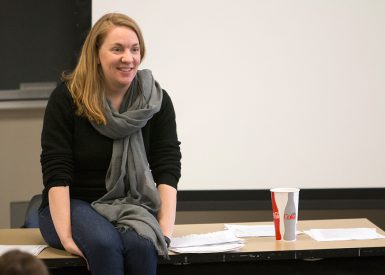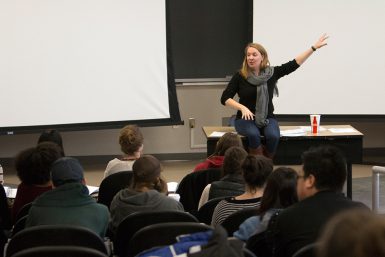Upworthy’s O’Leary discusses changing digital age, importance of storytelling

Emmy-nominated multimedia reporter Amy O’Leary talked to students Wednesday about how journalism is changing in the digital age and how the narrative skills of the past will translate into the future.
“Today content is infinite, but attention is finite,” said O’Leary, editorial director at Upworthy. “Our skills become more important than ever. People who are best at capturing that attention and channeling it will rule the world.”
O’Leary is the most recent in a series of award-winning journalists to speak to professor of practice Tom French’s Behind the Prize class. All of the speakers have won or have been nominated for top media awards.
O’Leary is a three-time Emmy nominee for her work on The New York Times’ website. She won the 2009 Gerald Loeb Award for “The Debt Trap” and the 2009 Knight Batten Award for “Living with Less,” both on NYTimes.com.
But her career didn’t start off so glamorously, O’Leary told students. She remembers quitting her first newspaper job after discovering a top advertiser was editing her stories before they were published.
Disenchanted, O’Leary worked other jobs before setting her sights on This American Life, the audio storytelling series.
“I just knew I had to be willing to work harder than other people,” O’Leary said of her efforts to switch from print to radio. She went as far as attending the Salt Institute for Documentary Studies in Portland, Maine, after she discovered most of the show’s producers studied there before working at This American Life.
“If you’re a journalist, you have to be really good at research,” O’Leary said. “I looked up everyone on staff and every intern they ever had. I found out all of them attended Salt, and that’s how I decided.”
She then transcribed 70 hours of tape for free and hired a comic book artist to brighten the look of her resume before landing a gig at This American Life — as an intern.

“When I got there as an intern, I looked around the room and I realized I just had to be better than one person in the room,” O’Leary said of her strategy to be hired fulltime.
Over the next 10 years, O’Leary worked her way up through the ranks of This American Life, then The New York Times. She worked as a multimedia producer and a news editor for NYTimes.com.
During those years, O’Leary developed many media strategies based on her observations of journalism in the digital age.
“Journalism used to be a simple process: Come up with the idea, report and create,” O’Leary said. “Now there’s a new layer: Packaging, because the way you tell your story matters, and promoting, because how you share it matters. The last two components are to listen and to respond. Journalists often get criticized for trying to be a megaphone, but the best journalists I know are incredible listeners.”
To explain the recent shift in the digital age, O’Leary showed two images from when the last two popes were announced. The first image, from 2005, showed a sea of people all watching the pope. The next image, from 2013, showed masses of people in St. Peter’s Square lit up by their mobile devices.
“A huge technological change that has taken place in our lifetime, and if we don’t think it has an effect on how people consume news, we’re about as well off as the passengers on the Titanic,” O’Leary said.
News pros have to be social media savvy and must consider feeds people use to consumer their news. The challenge is not only to get stories to show up on feeds, but also to draw readers to the engage with the story.
But even in the face of the changing media atmosphere, O’Leary stressed that the basics of journalism are still important in today’s media market, specifically narrative storytelling, which she said applies to all parts of the practice of journalism.
“The new digital work is not that different from the work that those of us who dreamed of being journalists dreamed about,” O’Leary said, showing examples in her slideshow presentation.
O’Leary said while it’s important to have many skills at one’s command, students should not get caught up in the notion of being a “one-man-band.”
“I think you should have a major and minor, and always be willing to dabble,” she told students. “The thing I care about most, my major, is narrative structure, and my minor is digital strategy.”

During the question and answer portion of her talk, several students were curious about how O’Leary kept herself marketable. Her advice was to always keep in mind storytelling, even when the story is about yourself.
“You need to have a story about your career,” O’Leary said. “You need to gather those skills, and you need to use those skills to create a story about who you are.
“Here’s my story: I want to get people’s attention. All my jobs fit under that umbrella. Amy O’Leary is about attention and time. If you think of it that way, it doesn’t seem like a hodgepodge of jobs. It looks like a path. It can be invented. There are no more career paths anymore.”
Professor of practice Tom French summed up in his introduction why O’Leary was a good addition to the speaker roster.
“She is wonderful with multimedia; she knows all kinds of stuff about social media and audio,” he said. “She knows a lot about journalism, and, even more amazing, Amy has the most informed, interesting take on where journalism is heading and the things that we need to do as we head into the future.”

